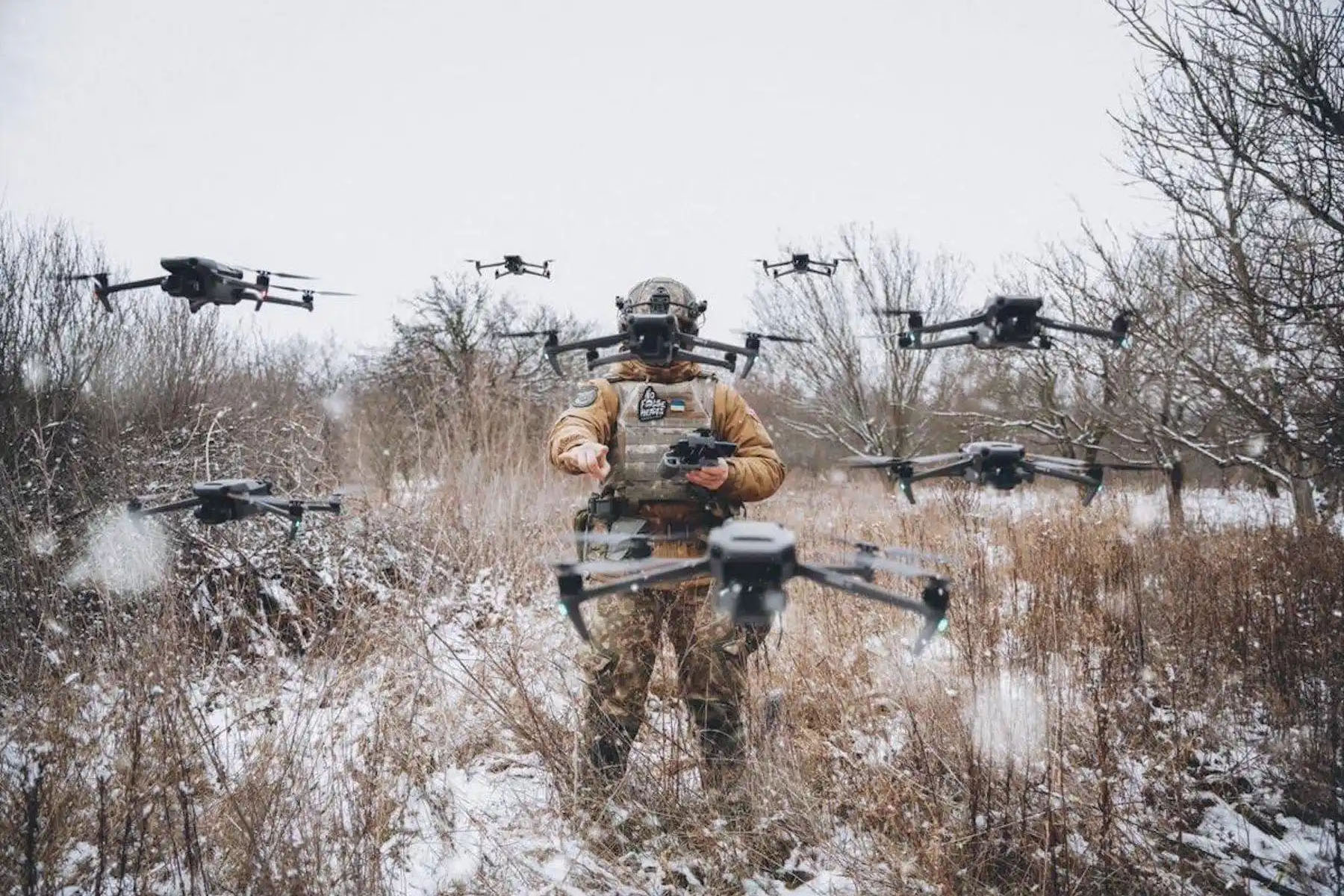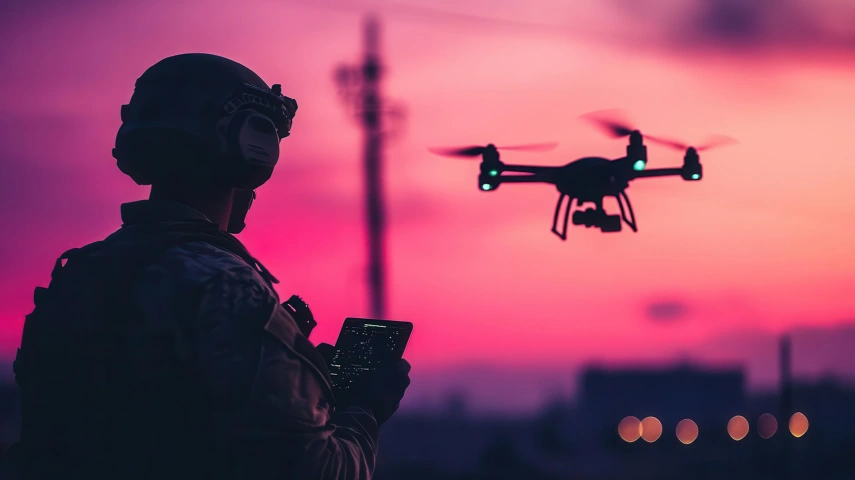In our previous article on FPV Drones Are Reshaping Modern Warfare, we examined how these agile and cost-effective FPV drones have become a disruptive force on the battlefield. Their ability to deliver precision strikes, conduct real-time reconnaissance, and disrupt enemy defenses has forced military strategists to rethink traditional doctrine. Now, we take a deeper dive into their tactical implications at the squad level, focusing on the Marine infantry squad—an essential combat unit that has had to rapidly adapt to this evolving threat landscape.
The battlefield has always been a dynamic and unforgiving environment, but the introduction of FPV combat drones has accelerated the pace of change. With their affordability, adaptability, and lethality, these combat UAVs are rewriting the rules of engagement, making survival contingent on superior tactics, deception, and countermeasures. This article explores how FPV drones are shaping modern infantry operations, examining the new realities of warfare faced by Marine infantry squads on the front lines.

Ukraine FPV Drones Are Reshaping Modern Warfare
The Challenge of Medevac—A Near-Impossibility in Modern Warfare
One of the most significant consequences of the FPV drone revolution is the increased difficulty of casualty evacuation (Medevac). In previous conflicts, wounded warfighters could be extracted quickly, often within the “golden hour,” reducing mortality rates. However, the modern drone-dominated battlefield—especially in high-intensity conflicts like Ukraine—has demonstrated that Medevac is now incredibly complex, with frontline units often needing to transport casualties 15-20 km away from enemy engagement zones before safe extraction is feasible.
FPV attack drones play a key role in this shift by continuously monitoring and striking logistical movements. Even well-coordinated evacuation convoys are at high risk of being targeted by drone swarms, which can strike with pinpoint accuracy and severely disrupt Medevac operations. As a result, Marine infantry squads must now prioritize prolonged field care, relying on combat lifesavers and advanced field medicine techniques to sustain wounded personnel for extended durations before evacuation becomes possible.
Individual Dispersion and Camouflage, Survival in a Drone-Dominated Battlefield
The days of tight formations and predictable movements are over. The Marine infantry squad, traditionally reliant on coordinated maneuvers, must now embrace extreme dispersion to mitigate the risk of FPV drone surveillance and aerial attacks. Small, widely spread-out teams reduce the effectiveness of enemy reconnaissance drones and minimize the likelihood of mass casualties from a single drone strike.
Additionally, camouflage and deception have become mission-critical. Infantrymen must utilize multi-spectral concealment to avoid detection across multiple spectrums, including infrared and radar. Detailed techniques are outlined in the U.S. Army Field Manual FM 20-3: Camouflage, Concealment, and Decoys. Movement drills now emphasize drop and concealment techniques, ensuring warfighters can rapidly blend into the battlefield environment when drone activity is detected.
Key camouflage measures include:
- Thermal suppression gear to reduce heat signatures and mislead infrared sensors.
- Decoys and false signatures to confuse FPV drone operators and disrupt target acquisition.
- Rapid relocation drills to ensure unpredictability and minimize exposure. Additional camouflage strategies can be found in the Techniques of Employing Camouflage, Cover, and Concealment.
-
Marine with Marine Rotational Force–Europe 19.2, Marine Forces, fires M240B machine gun in Chabanka, Ukraine, July 11, 2019 (U.S. Marine Corps/Williams Quinteros)
Countering the Drone Threat, Detection & Evasion Equipment
As FPV drones cement their role in How FPV Drones Are Reshaping Modern Warfare, counter-drone technology is evolving just as rapidly. Marine infantry squads must integrate drone detection and evasion tools into their operational playbook to stay ahead of the technological arms race. Some of the most effective countermeasures include:
- RF Jammers: Disrupt the signal between an FPV drone and its operator, causing immediate loss of control.
- Portable Drone Radars: Compact systems that detect enemy drones at long range and provide early warning to squads.
- Passive Detection Systems: Devices that listen for drone communications without emitting a signal, ensuring units remain undetected.
- Signal Spoofers: Technologies that hijack enemy drone signals and redirect them away from friendly positions.
These systems are already operational in multiple conflict zones, with Marine units leveraging early-warning networks to evade and neutralize incoming FPV drones before they become critical threats.
A Look at Modern Anti-Drone Systems—From Anduril to DARPA
To counter the growing FPV drone threat, leading defense firms and military research institutions are developing next-generation countermeasures. Some of the most promising technologies include:
- Anduril’s Lattice System: An AI-driven sensor network that autonomously detects, classifies, and neutralizes drone threats before they reach friendly forces.
- Lockheed Martin’s MORFIUS: A reusable drone interceptor that actively hunts and disables enemy FPV drones using directed energy weapons.
- DARPA’s Mobile Force Protection (MFP) Program: Focused on integrating advanced laser and electromagnetic counter-drone systems into frontline combat units.
These cutting-edge technologies represent the next evolution of drone warfare, shifting the operational balance by integrating autonomous and electronic warfare countermeasures directly into small-unit tactics.

This is How FPV Drones Are Reshaping Modern Warfare, The Marine Infantry Squad Perspective
Adapting to the New Reality of How FPV Drones Are Reshaping Modern Warfare
FPV drones have irrevocably altered modern infantry operations, forcing Marine squads to adapt in real time. The Marine infantry squad, once structured around direct engagements and fire superiority, must now incorporate drone evasion, deception tactics, and counter-drone technology into every facet of operations.
The future battlefield belongs to those who can outmaneuver, outthink, and out-adapt the enemy. As FPV drones continue to redefine the tempo of warfare, survival will depend on the seamless integration of dispersion tactics, electronic warfare, and adaptive camouflage into small-unit doctrine. Whether in urban combat, dense forests, or open terrain, modern warfighters must remain unpredictable, invisible, and technologically superior to survive the next evolution of drone warfare.
At Embleholics, we honor the adaptability, courage, and resilience of those who serve in the ever-changing landscape of How FPV Drones Are Reshaping Modern Warfare. Our custom challenge coins commemorate the legacy of warriors who stand at the forefront of technological evolution. If you want to create a lasting symbol of your unit’s excellence and perseverance, contact us today and let’s craft a coin that embodies your mission, values, and dedication to duty.
Until Next Time!


